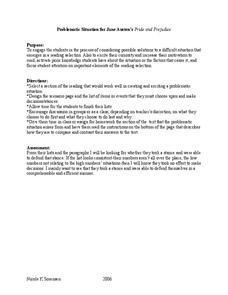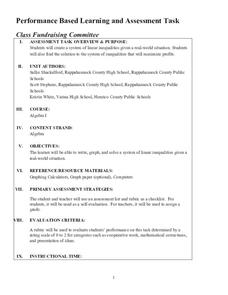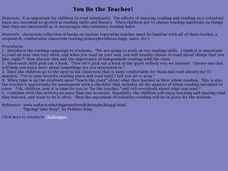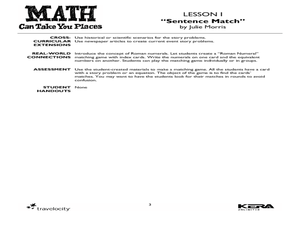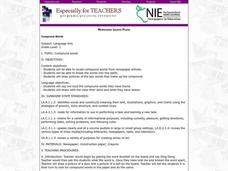Missouri Department of Elementary
To Give In or Not to Give In—That Is the Question!
No! A very simple word that can be very hard to say. Seventh graders have an opportunity to practice this difficult skill as they engage in a series of role-playing scenarios. As an exit ticket, 7th graders write a reflection on the...
Curated OER
Using Random Sampling to Draw Inferences
Emerging statisticians develop the ability to make inferences from sample data while also working on proportional relationships in general. Here, young learners examine samples for bias, and then use random samples to make...
Teach Engineering
All About Linear Programming
Class members connect engineering with an understanding of linear programming using a technical resource. Scholars learn about linear programming (linear optimization) and how it applies to engineering design in the first of two modules....
Houston Independent School District
Creating a Successful Project
Guide your learners step by step through the process of designing an original, independent student project. This resource includes a wealth of worksheets and materials, including student project checklists, timelines, primary and...
Charleston School District
Review Unit 4: Linear Functions
It's time to show what they know! An assessment review concludes a five-part series about linear functions. It covers all concepts featured throughout the unit, including linear equations, graphs, tables, and problem solving.
EngageNY
The Decimal Expansion of Some Irrational Numbers
Develop a definition of irrational numbers through an exploration of square roots. The 11th activity in this series of 25 asks scholars to estimate the value of a square root. Learners observe as the estimation extends further and...
Curated OER
Pride and Prejudice: Problematic Situation
What would you do if your sister ran off with a man whom you didn't trust? Explore a scenario based on Jane Austen's Pride and Prejudice. Once kids work though the problem, they read the appropriate chapters from the book and write...
Pearson Longman
Emotions Reading
Explore the many types of feelings and how people express them with a lesson compiled of kid-friendly activities that spark critical thinking, self-reflection, and reinforce language and writing skills. Scholars delve into the variety of...
Sunburst Visual Media
Respect: It Starts With You!
There are few things as frustrating to a teacher as a disrespectful student. Luckily this collection of activities, worksheets, and writing exercises is here to help eliminate this problem by teaching young leaners...
EngageNY
Using Tree Diagrams to Represent a Sample Space and to Calculate Probabilities
Cultivate the tree of knowledge using diagrams with two stages. Pupils create small tree diagrams to determine the sample space in compound probability problems. The lesson uses only two decision points to introduce tree diagrams.
Concord Consortium
King for a Day
Rumor has it exponential functions help solve problems! In a kingdom filled with rumors, young scholars must determine the speed a rumor spreads. The ultimate goal is to decide how many people must know the rumor for it to spread to the...
West Contra Costa Unified School District
Quadratic Equations — What We Know
Everything you could possibly want to know about quadratic equations, all in one resource. Instructors demonstrate how to translate between different forms of quadratics (equation, table of values, graph, verbal description) and finding...
Mathematics Vision Project
Systems of Equations and Inequalities
It's raining (systems of) cats and dogs! The fifth unit in a nine-part course presents systems of equations and inequalities within the context of pets. Scholars use systems of inequalities to represent constraints within situations...
Radford University
Class Fundraising Committee
Given the task of coming up with a fundraiser, small groups determine the type of fundraiser to hold and restraints on the number of participants. The classmates create inequalities to represent the constraints and graph the solution to...
Curated OER
You Be The Teacher
Young scholars create their own math problems with one restriction, the answer the teacher gives them must be kept in a sealed envelope. They may make up any kind of problem they like.
Curated OER
Research Cruise Word Problems
Young scholars examine life aboard the NOAA research vessel, Ronald H. Brown. They complete word problems related to the vessel, and then create three problems of their own.
Curated OER
Research Cruise Word Problems Lesson Plan
Students explore life onboard the NOAA Research Vessel Ronald H. Brown and practice basic arithmetic by completing word problems.
Curated OER
Sentence Match
Fifth graders explore the concept of equivalency. In this math lesson plan, 5th graders write their own word problems and pair them to appropriate algebraic number sentences.
Curated OER
Mrs. Perkins Dolch Words: #10 Create a Story
Students write their stories. In this sight words and writing lesson, students examine a list of 20 teacher-provided dolch words and use them to write their own stories. Students share their stories with their classmates.
Curated OER
Language Arts: Solch Sight Words
First graders recognize Dolch sight words on cards and texts. They practice the selected words by creating short sentences. After reading different fables, 1st graders create their own illustrations to accompany the stories. Once they...
Curated OER
Analyzing Unknown Words
Middle schoolers analyze affixes and how they affect word meaning. In this language arts lesson, students use charts to construct and deconstruct words to find meaning.
Curated OER
Equal Groups
In this dividing by two word problem worksheet, students use pictures and mental math to problem solve. Students solve six problems.
Curated OER
Exponents III- Squares and Square Roots
Students explore the process of inverse operations to solve square root problems. After exploring the perfect squares and area, students examine methods to find square roots by observing the teacher, taking notes, and listing vocabulary...
Curated OER
Compound Words
First graders read newspaper articles and locate compound words. They break the words into two parts, then draw pictures of the two words.






